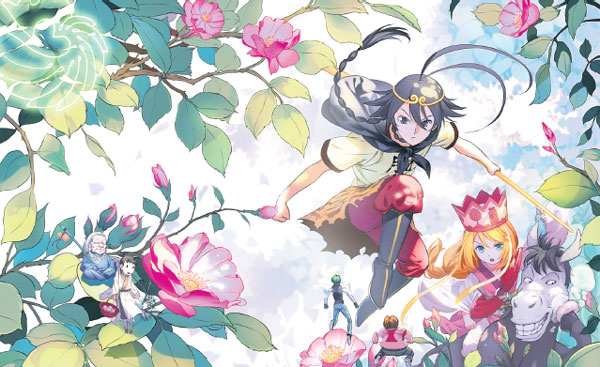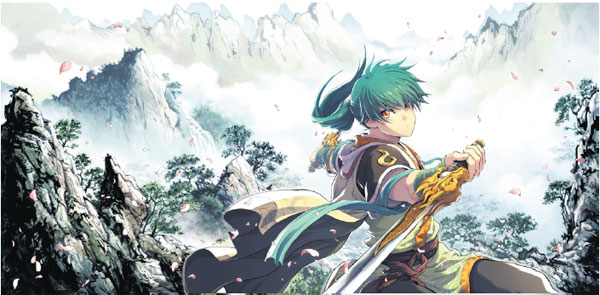Drawing attention

The internet is fueling new ways of looking at the Chinese comics industry
Chinese comics artist Bai Xiao used to wonder how his Japanese counterparts could churn out their creations on a weekly basis, when he could do so only once a month in magazines.
That was before he moved online. Now, Bai is equally prolific. He publishes his story Shikong Shitu (Bloodivores) on the online comics platform of internet giant Tencent twice a week, and he has completed more than 200 chapters so far.

| Chinese comics artists create comic strips with colorful topics, from fox-demon fantasy (top) to martial arts (above). Photos Provided to China Daily |
"The internet has changed Chinese comics profoundly," says Bai, 35, who is based in Beijing.
Bai started to draw comics in 2001, when magazines were the main platform for the genre. He published several stories in magazines such as Comic Artists, China Cartoon, and Comic Fans, one of the most influential comic magazines in China.
He switched to online comics less than two years ago. Shikong Shitu, a science fiction story, depicts a world full of conflicts caused by new technologies. A group of bloodsucking characters, the products of medical side effects, forms a major part of the storyline.
On Oct 1 last year, a Japanese cartoon version of Shikong Shitu began to be shown on Japanese TV station Tokyo MX, a day after the Chinese version rolled out online.
"I used to admire those who could offer stories that ran for as long as they wished in a month," says Bai. "Due to the limited number of pages in magazines, I was allowed to publish no more than 40 pages per month. I could not finish the opening parts of a story even in a whole year. Sometimes I had to delete plots to fit everything in, and the stories would not be perfect or complete."
Bai now produces about 100 pages of online stories a week, a number he says he could not have imagined a decade ago.
He has the space to give his creativity and storytelling skills full rein.
To satisfy the demand from his readers for "good stories", Bai set up a studio last year that hired assistants to help with the artwork.
"A studio is a more stable, creative group. I believe, with the market becoming more mature, the number of comics studios in China will increase," says Bai.
Better experience
The development of the internet has also fueled greater interaction between comics artists and their readers.
Although magazines in the past could receive more than 100 letters from readers, mostly serious fans, many editors were not able to reply to all of them. At that time, the artists were not able to adapt their stories to reflect feedback from their readers.
But social media platforms such as micro blogs now allow both sides to communicate regularly.
"Most of the interaction is enjoyable. It lets you know that there are plenty of readers paying attention to your work," says Bai.
"But sometimes it can be hard to handle."
Bai cites one case when he came up with a plot ending to "surprise" his readers, but some of them guessed it and spread it online, putting him in a fix.
"It took me several days to come up with another reasonable and beautiful ending," says Bai. "Still, it's interesting to have these 'games' with the readers. It gives me a sense of achievement and the confidence to come up with better stories."
The internet is not just a platform for artists to showcase their work. It also acts as an engine to power the development of the industry, he says.
The growing number of comics artists and their stories online have certainly helped to raise the quality of work, say many artists and their readers.
Yiren Zhixia, created by Mi Er, reveals the unusual lives of several people who are able to master superpowers related to traditional Chinese culture, such as the qi energy-flow concept in Taoism. Huyao Xiao Hongniang, a web comic created by Tuo Xiaoxin, tells of a series of interesting and mysterious love stories between Taoists and fox demons.
Both the stories are based on traditional Chinese culture, and the cartoon versions of them have been introduced to Japanese TV audiences over the past two years.
According to statistics released by the Qianzhan Industry Research Institute in March, at the end of 2016, China had 150,000 web comics created by more than 90,000 artists, receiving more than 200 billion hits from 70 million readers. Many of them had the habit of buying comic books or magazines in the past.
Zhang Han, 25, who works in the Ministry of Transport, is one fan who switched from magazines to websites. Zhang has been reading comics since elementary school. It helps her relax, and she reads them on her computer before going to sleep every night.
"I used to finish reading a whole magazine once I bought it, and wait for the latest installment in the weeks ahead. But the number of magazines was limited, and sometimes I could not get hold of one," she says.
Online comics can also be much cheaper than the magazines of the past, and many fans are reading them on the go via mobile apps.
"Many of my friends began to read comics on apps and I have tried that, but the pictures and words on smartphone screens are too small and my eyes can hurt," says Zhang. She usually follows several storylines at the same time, but reading them all on her mobile device means she would have to download many apps and deal with limited digital storage, she says.
Adapting to changes
Tencent Comics and Kuaikan Comics, both launched in 2014, are two of the most popular comics apps in the Chinese market, which is made up of hundreds of smaller players catering to a wide range of readers.
Li Yan, 20, majors in telecommunication engineering at Beijing Union University. She began to read comics on apps last year and has both comics apps installed on her smartphone.
Li was asked to select her gender the first time she used the apps because they were apparently customized to cater to different types of readers - girls and women usually went for romance stories, while boys and men would opt for violent ones.
"Sometimes I'd select the opposite gender to see what was being offered on the other side," says Li.
The increasing number of selections means she can pick the ones that are familiar to her daily life and interests, Li says. Her favorite comic is Junlin Chenxia, a fiction piece based on the history of the Three Kingdoms period (220-280).
"I used to read them on computers, which meant that I could only immerse myself in the world of comics when there was a computer around me," says Li.
"Now with apps on my phone, I can read the comics anywhere as long as I have it with me."
The interactive platforms on the apps also allow Li to communicate with people who share the same interests and hobbies.
Besides a standard feature for comments after each chapter for readers to express their opinions, Tencent also promotes its danmu, or "bullet screening", a real-time comment feature that flashes across readers' screens for them to share their ideas and feelings.
Kuaikan Comics offers a live communication platform on its app, which reduces the distance between comics creators and readers.
"We communicate like friends," says Li, adding that by interacting with creators in real time, she gets a deeper understanding of comic characters' personalities.
"Chinese culture in online comics is a natural link between the audience and the artist, making these comics easily understandable and popular among the young," says Song Lei, director of the development and research department of the China Animation Comic Game Group. Song started to focus on Chinese comics in the early 1990s.
He lauds the contribution made by the internet to growing the Chinese comics industry.
By leading more creators into the market as well as spreading more works among readers, the internet breaks down the barriers between readers and artists caused by the limited resources of traditional print, he says.
However, Song adds that since the barrier to entry for online comics is low and the regulations are still imperfect, there is the danger of undesirable content spreading among readers.
Better supervision and management of the market might help the sector develop in a more stable way, he says.
Xing Yi contributed to this story.
jiangyijing@chinadaily.com.cn
(China Daily Africa Weekly 10/27/2017 page10)
Today's Top News
- China's system contributes beyond nation
- Xi's article on unity, hard work to be published
- Xi urges full, rigorous CPC self-governance
- Grassroots Party units continue to play key role
- Global investors double down on Chinese assets
- FM's visit to Europe seen as boosting ties































